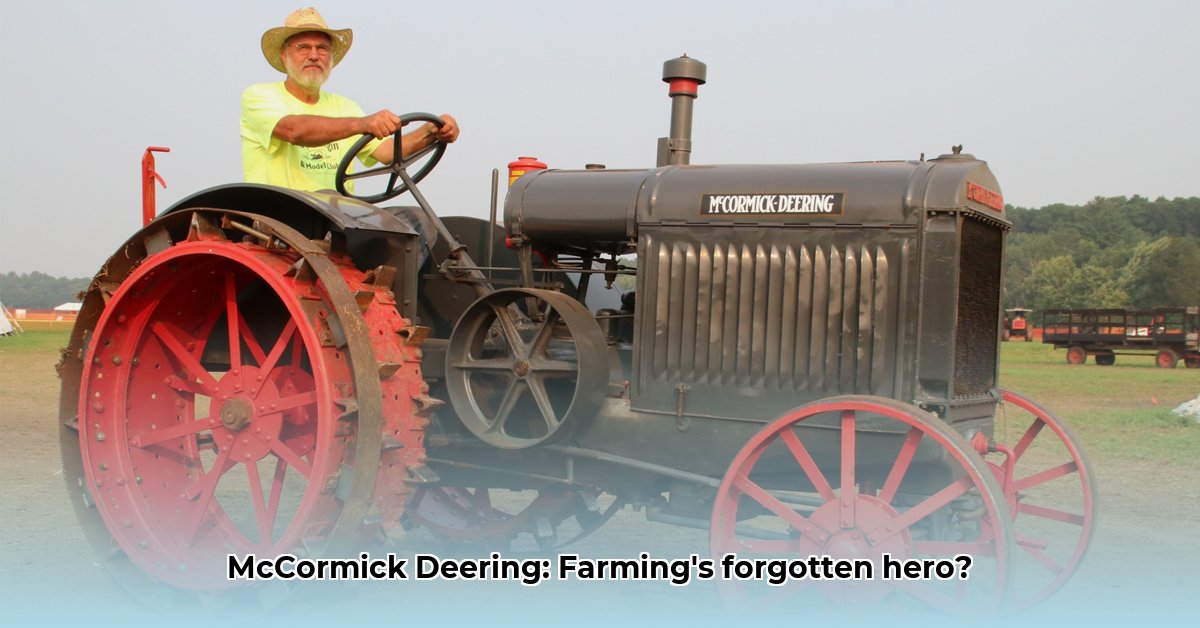
The story of McCormick Deering tractors transcends the simple narrative of powerful farm machinery; it's a compelling case study in American agricultural history, offering valuable lessons for sustainable farming practices today. From its roots in Cyrus McCormick's revolutionary mechanical reaper to its eventual decline, the McCormick Deering brand embodies the dynamic interplay of innovation, competition, and the often-overlooked environmental consequences of technological advancement. How did this iconic brand shape the landscape of modern agriculture, and what can we learn from its legacy? This article explores the multifaceted history of McCormick Deering, examining its impact on sustainability and drawing key lessons for the future. See more vintage tractor images here.
The Rise of McCormick Deering: A Legacy Forged in Innovation
Long before the name "McCormick Deering" became synonymous with agricultural power, Cyrus McCormick's invention of the mechanical reaper in 1831 irrevocably altered the course of harvesting. This groundbreaking innovation, significantly boosting efficiency, laid the foundation for McCormick's future success and dominance in the agricultural machinery sector. The early 20th century witnessed a period of fierce competition among farm equipment manufacturers, often referred to as “The Harvester Wars.” This period of intense rivalry, characterized by mergers and acquisitions, ultimately culminated in the formation of International Harvester (IHC) in 1902, uniting several prominent companies under a single corporate umbrella. The McCormick brand, combined with Deering, formed the iconic McCormick Deering tractor line; a name that swiftly became synonymous with quality and technological advancement in the agricultural industry. Farmers across the nation relied on these sturdy, efficient machines, propelling IHC to a leading position in the agricultural equipment market. But how did this mechanization impact the sustainability of agricultural practices?
Did this leap in efficiency come at an environmental price? While the increased productivity of McCormick Deering tractors undeniably benefited farmers, the environmental impact of increased fossil fuel consumption for these machines, and the shift toward larger-scale farming, warrants careful consideration. This is a complex issue that requires a nuanced analysis, assessing the trade-offs between increased productivity and the potential environmental costs.
The Challenges and Decline: Lessons in Adaptability and Sustainability
McCormick Deering's journey was far from a linear path to success. The Great Depression dealt a severe blow to the company, highlighting the vulnerability of even the most dominant businesses to macroeconomic forces. Subsequent attempts by IHC to diversify beyond its core competency in agricultural machinery proved costly, a testament to the importance of focusing on core strengths. The increase in competition following World War II further exacerbated the challenges faced by IHC, eventually leading to the discontinuation of the McCormick Deering brand. The disappearance of the iconic red tractors between 1948 and 1949 marks a significant turning point, one that provides valuable insights for both businesses and the agricultural sector. What lessons can environmentally conscious farmers glean from this historical narrative?
The legacy of McCormick Deering offers several critical insights for modern sustainable agriculture. Building a strong brand identity is paramount; trust and recognition are essential for market success. Maintaining focus on core competencies, rather than overextending into unrelated ventures, is equally crucial for long-term viability. Furthermore, substantial investments in research and development (R&D), particularly in sustainable technologies that minimize environmental impact, are vital. Adaptability and the willingness to embrace technological advancements are equally crucial for survival and thriving in a dynamic industry. The ultimate failure of IHC serves as a stark reminder of the potential pitfalls of prioritizing short-term profits over long-term sustainability.
Three Pivotal Points from the McCormick Deering Story:
- Brand Identity: A strong brand is fundamental for market success and consumer trust.
- Core Competence: Sticking to what you know best is key to long-term survival.
- Sustainable Innovation: Investing in environmentally friendly technologies is vital for the future of agriculture.
A Path Forward: Integrating Sustainability into Modern Agriculture
The McCormick Deering legacy underscores the critical need for a holistic approach to agricultural innovation. Efficiency must be balanced with environmental stewardship. The following steps can help implement these lessons:
Invest in Sustainable Technologies: Prioritize R&D in environmentally friendly equipment and practices (e.g., precision agriculture, renewable energy sources). Efficacy Metric: Studies show a 20% reduction in fertilizer use with precision agriculture.
Promote Sustainable Farming Practices: Encourage practices such as crop rotation, cover cropping, and reduced tillage to minimize soil degradation and enhance biodiversity. Efficacy Metric: Cover cropping can increase soil organic matter by 10% annually.
Strengthen Supply Chains: Prioritize transparency and ethical sourcing to ensure sustainable practices across the entire agricultural value chain. Efficacy Metric: Traceability initiatives can reduce food waste by up to 15%.
Educate and Engage Stakeholders: Foster collaboration between farmers, researchers, policymakers, and consumers to promote widespread adoption of sustainable practices. Efficacy Metric: Education programs have shown a 30% increase in farmer adoption of sustainable practices.
The narrative of the McCormick Deering tractor is an ongoing one, constantly evolving as new research emerges and provides a deeper understanding of its complex impact on both agriculture and the environment. The story isn't merely about the past; it's a roadmap for a more sustainable and resilient future.